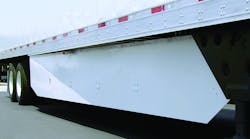As many of you know, NACFE is celebrating its 10th anniversary this year. And this seems like a good time to reflect on some of the fuel-saving technologies that have seen widespread adoption since NACFE’s inception. We track 85 technologies in our Annual Fleet Fuel Study and you can see what 20 major North American fleets have found helps them achieve their fuel efficiency goals.
In no particular order here are technologies and practices that are making today’s fleets more efficient.
1. Automated manual transmissions: The rise in the specification of AMTs while not meteoric has been impressive. Not only do AMTs improve fuel economy by 1% to 3% they also help with driver attraction and retention. We have spoken to fleet managers who have indicated that 100% of their new vehicle orders are equipped with AMTs.
2. Tire monitoring/inflation systems: Given that there is a 0.5% to 1% increase in fuel consumption when a tire is underinflated by as little as 10 psi, more fleets are investing in tire monitoring or inflation systems to keep tires inflated to their proper pressure. Some systems require driver intervention while others automatically inflate the tires. A bonus to properly inflated tires is longer tire life and fewer roadside breakdowns.
3. Trailer skirts: Also called fairing, trailer skirts are the most popular devices for addressing aerodynamic drag on trailers. The most effective skirts extend from the landing gear to the front face of the front trailer axle and are as low to the ground as possible. In 2016 I reported on an informal study of trailer aerodynamic devices and at that time found that 62% of the trailers on the road had some type of trailer aero device on them, with skirts showing the highest uptake.
4. Trailer tails: The flat back of a trailer is a huge contributor to aerodynamic drag. Trailer tails reduce the wakefield following the trailer. New models that deploy without driver intervention have made them increasingly popular.
5. Idle Reduction: Driving trucks is a tough job and made even harder when the drivers sleep in the trucks for nights if not weeks on end. Devices that help limit the amount of truck idling when “hoteling” and improve the comfort in the cab has improved immensely over the decade. It can be confusing though as many solutions offer different benefits and challenges.
6. Solar panels: Batteries on today’s trucks are not able to meet the power needs of newer trucks. Solar panels are being added to trailers to augment power coming from the alternator. Solar panels provide additional charging capacity for reefer units, electric liftgates and telematics devices too.
7. Low rolling resistance tires: Low rolling resistance tires save a significant amount of fuel compared to tires that are not designed for low rolling resistance. Since rolling resistance makes up 30% to 33% of the total fuel cost of a Class 8 truck, fleets are switching to low rolling resistance tires in large numbers.
8. Tractor aerodynamics: Over the past decade tractor aerodynamics have become the standard. Much attention was focused on improving tractor aerodynamics when fuel prices went to $4 a gallon. Truck makers have invested heavily in making their base models sleek and aerodynamic.
9. Electronic engine parameters: Fuel economy gains of 0.5 mpg to as much as 8% can be gained when a fleet optimizes the vehicle’s electronic engine parameters for fuel economy. While parameters have been around since the mid-1980s, many fleets are now working to fine tune parameter setting for their specific operation. Aside from a little time, this is a cost-free way for a fleet to get a boost to their MPG.
10. Driver training: The driver plays a huge role in how efficiently a truck performs. In fact, they may have as much as a 20 to even 30% impact on overall fuel efficiency. Buying and installing a fuel-saving technology is not enough, drivers must understand how the technology operates and what its benefits are. The seven drivers who participated in Run on Less are passionate about getting the most miles out of a gallon of fuel and demonstrate the vital drivers play in reaching MPG goals.




